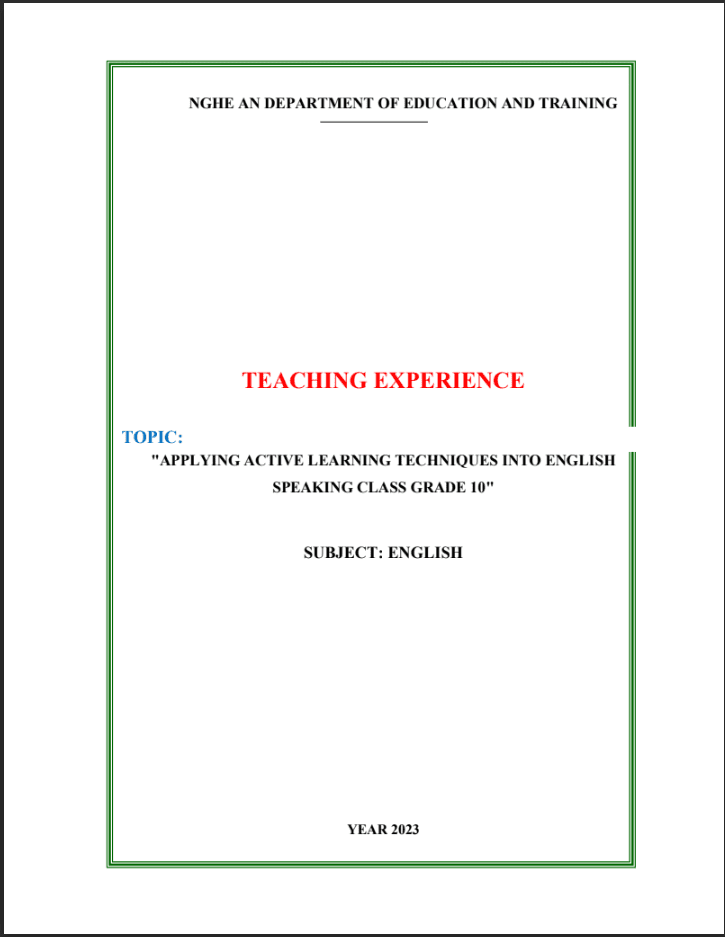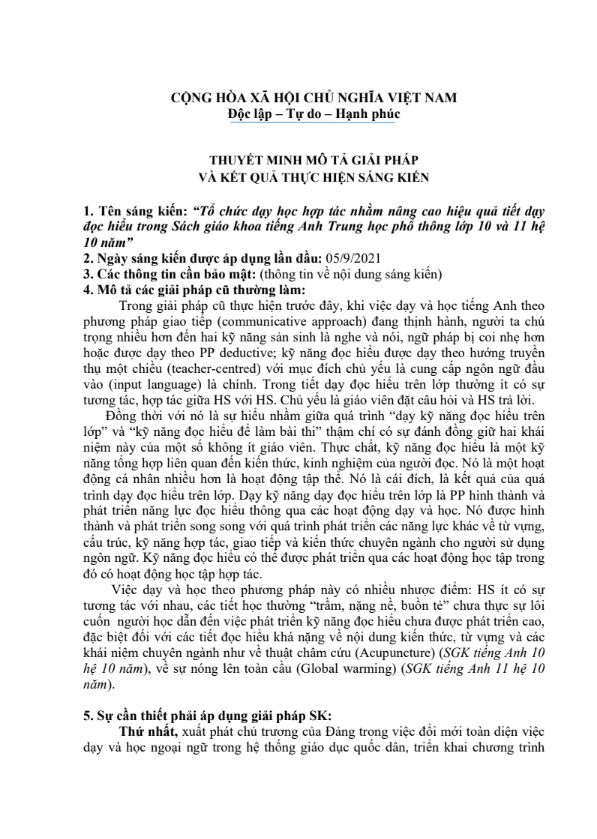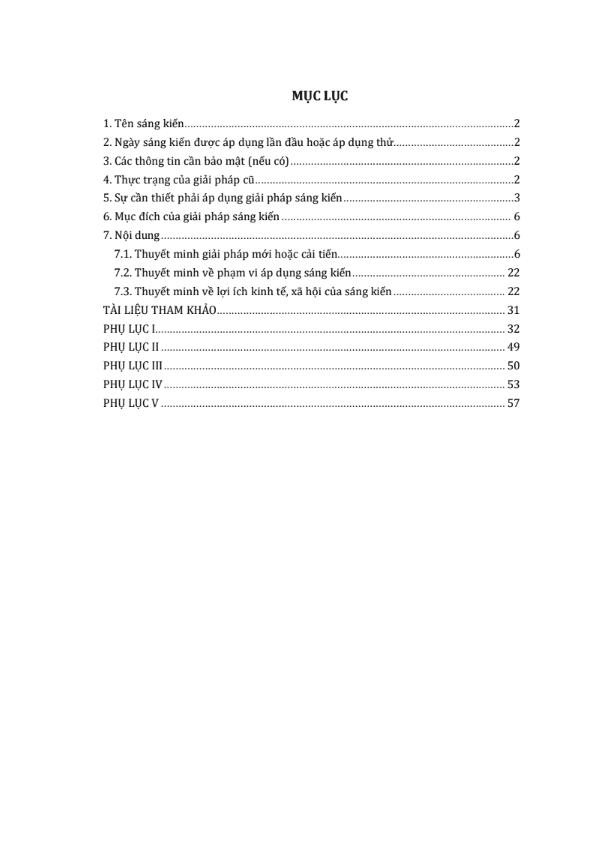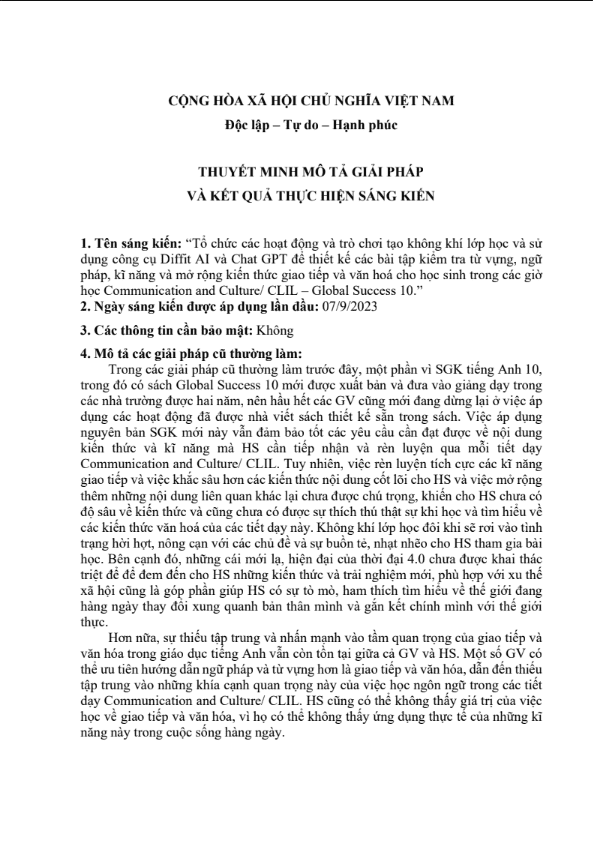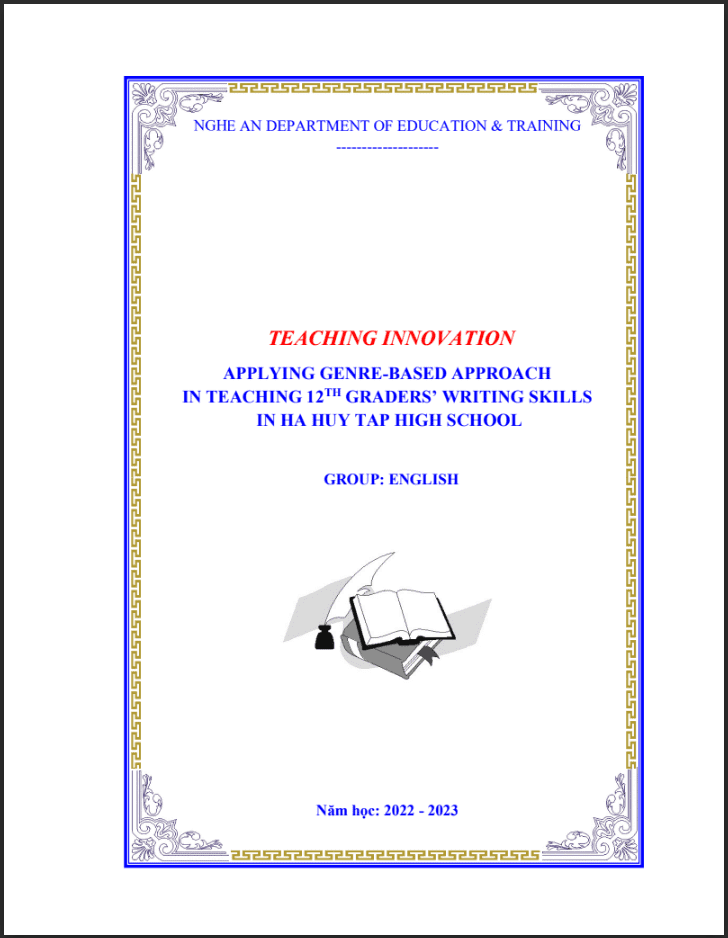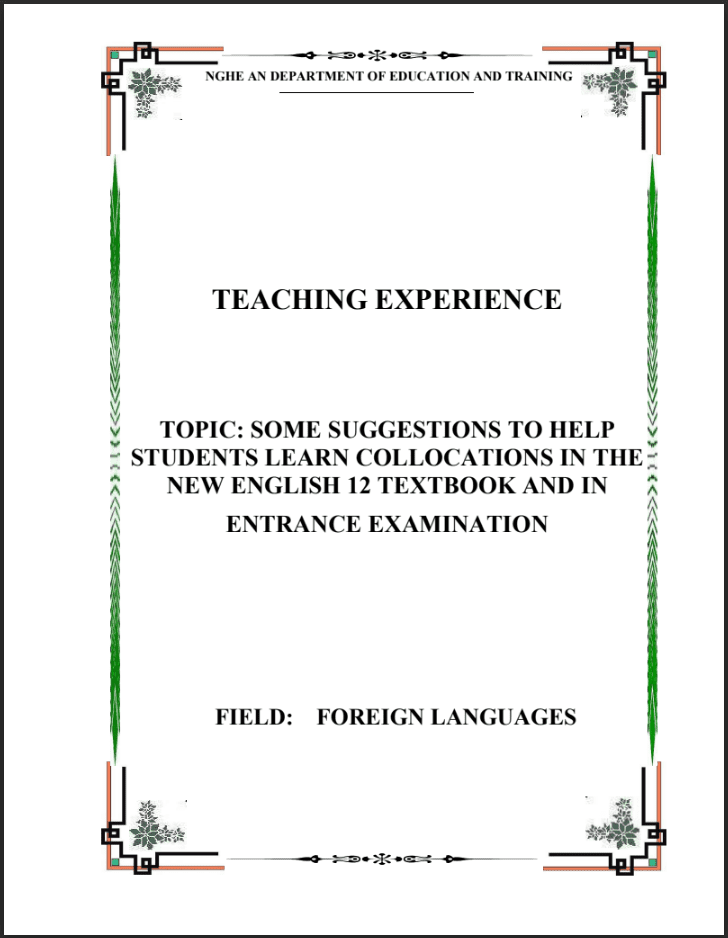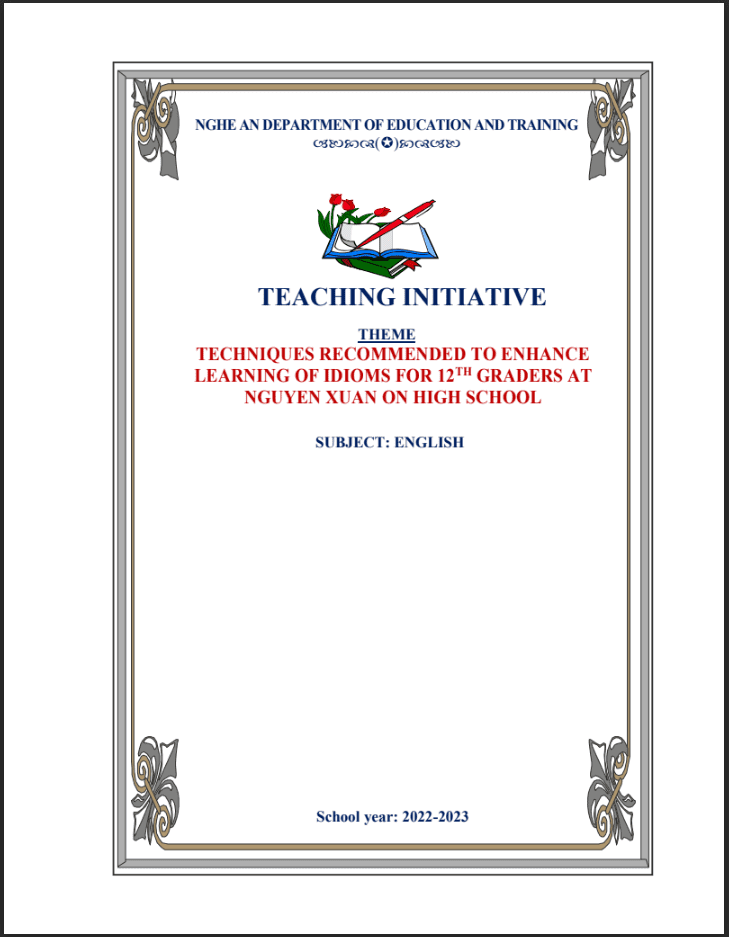SKKN Applying active learning techniques into english speaking class grade 10
- Mã tài liệu: MP0076 Copy
| Môn: | Tiếng Anh |
| Lớp: | 10 |
| Bộ sách: | Global Success |
| Lượt xem: | 557 |
| Lượt tải: | 5 |
| Số trang: | |
| Tác giả: | Đặng Thị Diệu Linh |
| Trình độ chuyên môn: | Thạc sĩ giáo dục |
| Đơn vị công tác: | THPT Thái Hòa |
| Năm viết: | 2022-2023 |
| Số trang: | |
| Tác giả: | Đặng Thị Diệu Linh |
| Trình độ chuyên môn: | Thạc sĩ giáo dục |
| Đơn vị công tác: | THPT Thái Hòa |
| Năm viết: | 2022-2023 |
Sáng kiến kinh nghiệm “Applying active learning techniques into english speaking class grade 10″triển khai gồm các biện pháp nổi bật sau:
Mô tả sản phẩm
PART I: INTRODUCTION
. The background of the study:
Nowadays with the sharply development of the technology, science and economy,
1
education plays an important role in society. English becomes an essential tool that
helps the youth succeed in many fields such as business, finance, education and
technology. Students who are fluent in English can have the chances to contribute to
the development of their country. The need to master English of the language learners
has forced the instructors to find the new way making the lessons more effective. The
question is raised to the teachers in many high schools all over the country is that
how can we make our lessons more interesting and make English more attractive. In
fact, one of the skills that English learners find it hard to master is speaking skill.
There are lots of people who have 12 years learning English but can not use it for
communicating. The high school students lack of passion for learning English. A
common problem that occurs in a speaking class is that instructors frequently feel it
difficult to involve students in the speaking activities. In fact, English instructors
should work hard to attract the students to speak a lot in the class. However, the result
is not up to their expectation. So how can the teachers help improve students’
speaking skill? Active learning, therefore, is supposed to help in solving this problem.
It emphasizes the significance of the learner’s involvement in the learning process
and may involve independent inquiry, collaborative learning and self-awareness of
the individual’s own learning process. I hope that this research will suggest some
ways for the teachers to make their lessons more exciting.
2
. Aims and Objectives of the study
The contributions of this research are conveyed to:
First, designing some activities for English speaking lesson using active learning
techniques and make a contribution to teaching materials.
Second, giving the effective ways to teach speaking skill.
Third, assisting students a lot in practise speaking English actively.
3
. The scope of the study:
The study deals with the problems that students of the 10th grade at Thai Hoa
High School usually have when they have speaking lesson in classrooms. These
problems are caused by some factors. Some solutions and implications will be given
for students in speaking skill.
4
. Methods of the study.
To complete my study, I
–
–
–
Read reference books.
Draw from experience of my own teaching
Learn and exchange teaching experiences with my colleagues.
1
–
Carry out surveys and tests among grade 10 students.
5
. Study and experimental time
This research has been applying for teaching speaking skill at class 10A, 10C 10M
of Thai Hoa high school during the school year 2022-2023.
PART II: INVESTIGATION
CHAPTER 1: LITERATURE REVIEW
1
1
. Active learning techniques
.1. Definition of active learning techniques
“Learning is not a spectator sport. Students do not learn much just by sitting in class
listening to teachers, memorizing prepackaged assignments, and spitting out answers.
They must talk about what they are learning, write about it, relate it to past
experiences, apply it to their daily lives. They must make what they learn part of
themselves.” – A. Chickering and Z.f. Gamson, “Seven principles for good practice”.
AAHE Bulletin 39 (March, 1987), 3-7. From this opinion, it can be seen that learning
in general and learning a language in specific is a complex and long process. Practice
makes perfect. If students take part in learning process, they will learn more. Active
learning is any learning activity in which students participate or interact with learning
process. In recent years, the term active learning has become increasingly common
among English classes. The English teachers all over the world are trying to make
students more active, more involved in the lessons.
After a long time teaching English at a high school, I see that the common problem
that happen in many English speaking lesson is that students feel shy to speak in an
English speaking class because of the anxiety of making mistakes due to lack of
grammar, vocabulary, structures and ideas. In fact, English instructors must have
worked hard to attract the students to speak a lot in the class. However, the result is
not up to their expectation.
Active learning is alleged to help in solving this problem. It focuses on the
significance of learner’s involvement in learning process.
Firstly, active learning helps develop collaborative skill. When using the methods to
encourage active leaning, the teachers will ask students to work with other students,
so they have chance to improve group collaborative skill.
Secondly, active learning is a good way to increase engagement. Students who are
actively learning will actively engaged. They will excitingly participate in each
classroom activities.
Thirdly, active learning encourages risk taking. It pulls students out of their comfort
zone and forces students to share their ideas with others so through learning tasks,
students will gain confidence and self-possession.
In short, active learning has brought lots of benefits to an English class.
2
1
.2. Some active learning techniques for teaching speaking skill.
Think-pair-share:
The teacher states an open-ended question. Ask students to spend a minutes or two
thinking about and writing a response. Then ask students to pair with a partner to
discuss their responses. Reconvene the class after a few minutes and call on individual
students to share their pair’s responses
Brainstorming:
Students are asked to generate ideas on a certain topic, category or question while you
facilitate and record the answers on the blackboard. Encourage students to draw on
prior knowledge and experiences. It is important to acknowledge all the answers
during this idea generation period.
Discussion:
Discussions can be useful both in-class or online, and can be adapted to any class size
(although more effective in smaller group settings). In a discussion, the instructor
facilitates students’ learning experience. Discussion requires students to think
critically, and to evaluate their own and other’s responses. Students are able to explore
a diversity of perspectives, and build on each other’s knowledge and understanding
of the content. Discussions help students develop the skills of knowledge synthesis
and integration.
Picture Prompt
Show students an image with no explanation, and ask them to identify/explain it, and
justify their answers. Or ask students to write about it using terms from lecture, or to
name the processes and concepts shown. Also works well as group activity. Do not
give the “answer” until they have explored all options first.
Three step interviews:
Use the three step interview process, divide students into groups of three, and assign
three roles: interviewer, interviewee, and notetaker. After that, also assigning a theme
or topic of discussion, have students participate in a five to 10 minutes interview to
discuss what they found to be the key information relating to the topic. After each
interview, having students rotate roles. Depending on factors including the grade level
of your students and their experience with the strategy, you may adjust the length of
the time for each interview.
True or false:
Distribute index cards (one to each student) on which is written a statement. Half of
the cards will contain statements that are true, half false, students decide if theirs is
one of the true statements or not, using whatever means they desire.
TÀI LIỆU LIÊN QUAN
- 7
- 105
- 1
- [product_views]
- 5
- 173
- 2
- [product_views]
- 4
- 165
- 3
- [product_views]
- 4
- 129
- 4
- [product_views]
100.000 ₫
- 6
- 434
- 5
- [product_views]
100.000 ₫
- 2
- 507
- 6
- [product_views]
100.000 ₫
- 9
- 546
- 7
- [product_views]
100.000 ₫
- 4
- 409
- 8
- [product_views]
100.000 ₫
- 2
- 595
- 9
- [product_views]
100.000 ₫
- 0
- 538
- 10
- [product_views]

